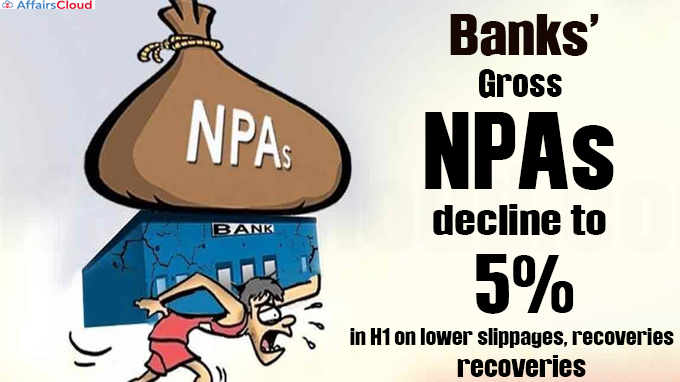
According to the Report on Trend and Progress of Banking in India 2021-22 published by the Reserve Bank of India(RBI) on 27th December 2022, the Gross Non-Performing Assets (GNPA) ratio of Scheduled Commercial Banks (SCBs) declined to 5% in September 2022 from 9% in 2017-18.
- This is an annual report, a statutory publication in compliance with Section 36 (2) of the Banking Regulation Act, 1949.
- This decrease was led by lower slippages and a reduction in outstanding GNPAs through recoveries, upgradations and write-offs.
- The report presents the performance of the banking sector, including cooperative banks and non-banking financial institutions, during 2021-22 and 2022-23 so far.
Highlights:
i.The consolidated balance sheet of Scheduled Commercial Banks (SCBs) showed double digit growth in 2021-22, after a gap of seven years, led by credit growth, which accelerated to a ten-year high in the first half of this financial year ending March 2023 (H1:2022-23).
ii.The capital to risk weighted assets ratio (CRAR) of SCBs strengthened from 16.3% at end-March 2021 to 16.8% at end-March 2022.
- All banks met the regulatory minimum capital requirement of 11.5%, and common equity tier-1 (CET-1) ratio requirement of 8%.
iii.The financial performance of Urban Co-Operative Banks (UCBs) improved in 2021-22, due to augmented capital buffers, a decline in GNPA ratio and improved profitability indicators.
iv.The NBFC (Non-Banking Financial Company) sector also maintained liquidity buffers, adequate provisioning, and a strong capital position during 2021-22.
Key Points:
i.In the case of PSBs (Public Sector Banks), the reduction in NPAs was mainly contributed by written-off loans. For PVBs (private banks), the upgradation of loans was the key reason for their asset quality improvement.
ii.As of March 2022, gross NPAs were at 5.8%, lower than 7.3% in March 2021.
iii.As of March 2022, the net NPA ratio improved to 1.7% from 2.4%.
iv.The share of large borrowers accounts, those with a total exposure of Rs 5 crore and above, comprised 47.8% of the total advances in 2021-22 compared with 48.4% in 2020-21.
- Correspondingly, their share in total NPAs also declined to 63.4% from 66.4%.
v.The share of Special Mention Accounts-0 (SMA-0), loans that are overdue for 0-30 days, increased for both PSU and PVBs as of March 2022.
Banks may need to lift deposit rates as credit demand surges
As per the report, the banks may need to raise deposit rates more to meet a surge in credit demand. This is due to an increase in the credit growth during 2021-22, the incremental credit-deposit (C-D) ratio reached a four-year high,
- Loans of Indian banks also rose 17.5% in the two weeks to December 2, 2022 from December 2021, while deposits rose 9.9%.
Only 8.2% of 463 million Jan Dhan accounts are zero balance
Pradhan Mantri Jan Dhan Yojana (PM-JDY) accounts in India saw an increase in the deposit base during the past eight years. By August 2022, out of a total of 462.5 million PMJDY accounts, 81.2% were operative, up from 76% in 2017. Only 8.2% of PMJDY accounts were zero balance accounts.
- A PMJDY account is regarded as inoperative if there are no customer-induced transactions in it for two years.
- At end-August 2022, about 56% of account holders were women and 67% PMJDY accounts were in rural and semi urban areas.
Number of Banking Frauds increased in FY22; substantially down by value
In FY21-22, the banking frauds increased in number terms but the amount involved more than halved.
- In FY22, banks reported 9,102 frauds of Rs 60,389 crore against 7,358 frauds with an amount involved of Rs 1.37 lakh crore in FY21.
Key Points:
i.The number of frauds which are related to advances or lending activities has been on a declining trend, with FY22 reporting 1,112 frauds of Rs 6,042 crore, which is lower than 1,477 frauds of Rs 14,973 crore in FY21 and 1,947 frauds of Rs 32,386 crore in FY20.
ii.The number of fraud cases reported by private banks are more than PSBs for the second consecutive year in FY22.
iii.In H1FY23, banks reported 5,406 frauds involving Rs 19,485 crore, as compared to 4,069 frauds involving Rs 36,316 crore for H1FY21.
iv.There were 3.04 lakh complaints registered by customers at RBI Ombudsman offices, as against 3.41 lakh in FY21 and 3.06 lakh in FY20.
- Nearly three-fourths of the complaints came from urban and metropolitan areas.
v.98.2% of the complaints by pensioners were filed against PSBs, while private banks led with a 46% share in levy of charges without prior notice.
Private banks lead in credit growth in Q2FY23 as demand grows
PVBs surpassed PSBs in September 2022 by increasing their share in total credit to 38.4% from 37.5% a year ago due to increase in demand.
Key Points:
i.According to CARE Ratings assessment, the loan portfolio of private sector banks grew 20.6% year-on-year (Y-o-Y) at end of September 2022. For PSBs, it grew 18.7% in the same period.
ii.Bank credit growth (y-o-y) accelerated further to 18% in September 2022, compared with 14% a quarter ago and 5.8% a year ago.
Realization through IBC 201% of liquidation value as of Sept
In cases where corporate insolvency resolution processes (CIRPs) were initiated under the Insolvency and Bankruptcy Code by financial creditors (FCs), realisations until September 2022 were close to 201 per cent of the liquidation value.
- SARFAESI (Securitisation and Reconstruction of Financial Assets and Enforcement of Security Interest) and Debt Recovery Tribunals have yielded recovery rates comparable to the IBC mechanism.
- The recovery rate under the IBC stood at 23.8%, while the rates under SARFAESI Act and DRTs stood at 25.7% and 22.5%, respectively.
About Reserve Bank of India (RBI):
Governor– Shaktikanta Das
Deputy Governors– Mahesh Kumar Jain, Michael Debabrata Patra, M. Rajeshwar Rao, T. Rabi Sankar
Headquarters– Mumbai, Maharashtra
Establishment– 1st April 1935




